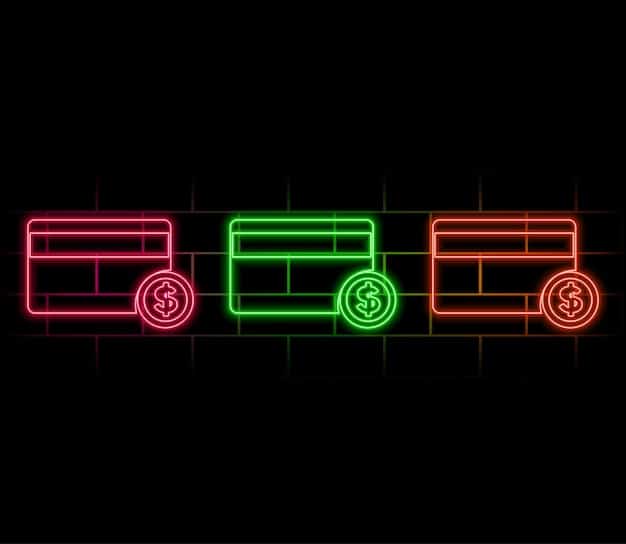The Pros & Cons of 0% APR Balance Transfer Credit Cards

Weighing the pros and cons of using a 0% APR balance transfer credit card to pay off debt is crucial for making informed financial decisions, as it involves understanding potential savings, fees, and the importance of a solid repayment plan.
Are you struggling with high-interest debt? A 0% APR balance transfer credit card might seem like a lifeline, offering a temporary reprieve from those crushing interest charges. However, like any financial tool, it’s essential to understand both the benefits and drawbacks before diving in. Let’s explore whether this strategy is the right move for you.
Understanding 0% APR Balance Transfer Credit Cards
A 0% APR balance transfer credit card is a credit card that offers a promotional period during which purchases or balance transfers are not subject to interest charges. This can be a great opportunity for consumers who are looking to save money on interest fees or pay down debt faster.
How Balance Transfers Work
A balance transfer involves moving high-interest debt from one or more credit cards to a new credit card with a lower, often 0%, interest rate. The key is to pay off the transferred balance within the promotional period, usually between 6 and 21 months, to avoid accruing interest at the standard rate, which can be significantly higher.
Key Features to Look For
- Promotional APR Period: The length of time the 0% APR is in effect.
- Balance Transfer Fees: Fees charged for transferring the balance, typically a percentage of the transferred amount (e.g., 3-5%).
- Credit Limit: The amount you can transfer, which depends on your creditworthiness.
- Standard APR: The interest rate that applies after the promotional period ends.
Understanding these features is the first step in determining whether a 0% APR balance transfer credit card aligns with your financial goals. Ignoring these aspects could lead to unexpected costs and negate the potential benefits.
The Pros of Using a 0% APR Balance Transfer Card
There are several compelling advantages to using a 0% APR balance transfer card, particularly if you’re carrying a significant balance on high-interest credit cards. It can provide much-needed breathing room and accelerate your debt repayment efforts.
Saving Money on Interest
This is the most obvious benefit. By transferring your balance to a card with a 0% APR, you can avoid paying interest charges for a specified period. This allows you to put more of your payments toward the principal balance, reducing your debt faster.
Accelerated Debt Repayment
- Focus on Principal: Without interest accruing, every payment you make goes directly toward reducing your debt.
- Clear Timeline: The promotional period gives you a defined timeframe to pay off the balance.
- Motivation Boost: Seeing your debt decrease rapidly can be highly motivating.
Simplifying Debt Management
Instead of juggling multiple credit card payments with varying due dates and interest rates, a balance transfer consolidates your debt into a single, manageable payment. This simplifies your finances and reduces the risk of missed payments.

The Cons and Potential Pitfalls
While 0% APR balance transfer cards can be beneficial, they also come with potential drawbacks that you should be aware of. Understanding these pitfalls can help you avoid common mistakes and maximize the card’s benefits.
Balance Transfer Fees
Most balance transfer cards charge a fee, typically 3-5% of the amount transferred. This fee can eat into your savings, especially if you’re transferring a large balance. It’s important to calculate whether the interest savings outweigh the transfer fee.
The Danger of Overspending
The allure of a 0% APR can sometimes lead to overspending on the new card. If you’re not careful, you could end up with even more debt than you started with. It’s crucial to use the card responsibly and stick to your repayment plan.
Credit Score Impact
- Initial Dip: Opening a new credit card can temporarily lower your credit score due to a new inquiry and a shorter credit history on that account.
- Utilization Ratio: Transferring a large balance can increase your credit utilization ratio (the amount of credit you’re using compared to your total available credit), which can negatively impact your score.
These potential credit score impacts are usually temporary and can be mitigated by responsible credit management. However, they are important factors to consider.
Strategies for Maximizing the Benefits
To make the most of a 0% APR balance transfer card, it’s essential to have a well-thought-out strategy. Simply transferring the balance and hoping for the best is often not enough. Careful planning and disciplined execution are key.
Create a Repayment Plan
Before you transfer any balances, calculate how much you’ll need to pay each month to pay off the entire balance within the promotional period. Set up automatic payments to ensure you never miss a due date.
Avoid New Purchases
Ideally, you should avoid making new purchases on the balance transfer card. This will help you focus on paying down the transferred balance and prevent you from accumulating more debt.
Monitor Your Credit Score
- Track Changes: Keep an eye on your credit score to see how the balance transfer affects it.
- Address Issues: If you notice a significant drop, review your credit report for any errors or issues that need to be addressed.
Regular monitoring can help you stay on track and make informed decisions about your credit management.

Alternatives to Balance Transfer Cards
While 0% APR balance transfer cards can be a great option, they’re not the only way to tackle high-interest debt. Exploring alternative strategies can help you find the best fit for your financial situation.
Debt Consolidation Loans
Debt consolidation loans involve taking out a personal loan to pay off multiple debts, combining them into a single loan with a fixed interest rate. This can simplify your finances and potentially lower your interest rate.
Credit Counseling
Credit counseling agencies can help you create a budget, negotiate with creditors, and develop a debt management plan (DMP). A DMP typically involves making a single monthly payment to the agency, which then distributes the funds to your creditors.
The Debt Snowball or Avalanche Method
- Snowball Method: Focuses on paying off the smallest debts first to gain momentum and motivation.
- Avalanche Method: Prioritizes paying off the debts with the highest interest rates first to save the most money in the long run.
These methods are effective for those who prefer a more structured approach to debt repayment.
Making the Right Decision for You
Deciding whether to use a 0% APR balance transfer card requires careful consideration of your financial situation, goals, and discipline. There’s no one-size-fits-all answer. Evaluate your options, weigh the pros and cons, and choose the strategy that aligns with your needs.
Assess Your Financial Situation
Consider your current debt load, spending habits, and ability to make timely payments. If you’re prone to overspending or frequently miss payments, a balance transfer card might not be the best choice.
Compare Offers Carefully
Don’t just grab the first offer you see. Compare multiple balance transfer cards to find the one with the most favorable terms, including the lowest transfer fee, the longest promotional period, and the best standard APR.
Seek Professional Advice
If you’re unsure whether a balance transfer card is right for you, consider seeking advice from a financial advisor. They can help you assess your situation and develop a personalized debt repayment plan.
| Key Point | Brief Description |
|---|---|
| 💰 Interest Savings | Avoid interest during the promotional period. |
| ⚠️ Balance Transfer Fees | Fees can reduce overall savings. |
| 📅 Repayment Plan | Essential to pay off balance on time. |
| 📊 Credit Score Impact | Can temporarily affect your credit score. |
Frequently Asked Questions
It’s a credit card offering a promotional period with no interest on transferred balances, helping you pay down debt faster by focusing on the principal amount.
Yes, most cards charge a balance transfer fee, usually a percentage of the amount transferred. This fee should be considered when evaluating savings.
Opening a new card may temporarily lower your score, and a high balance can increase your credit utilization. Responsible management can mitigate negative effects.
After the promotional period, any remaining balance will accrue interest at the card’s standard APR, which can be higher than your original cards.
If you can’t pay it off, consider other debt relief options or transfer the balance to another 0% APR card if available and cost-effective.
Conclusion
In conclusion, a 0% APR balance transfer credit card can be a powerful tool for debt repayment, provided you understand its potential benefits and drawbacks. By creating a solid repayment plan, avoiding new purchases, and monitoring your credit score, you can maximize the benefits and achieve your financial goals.





